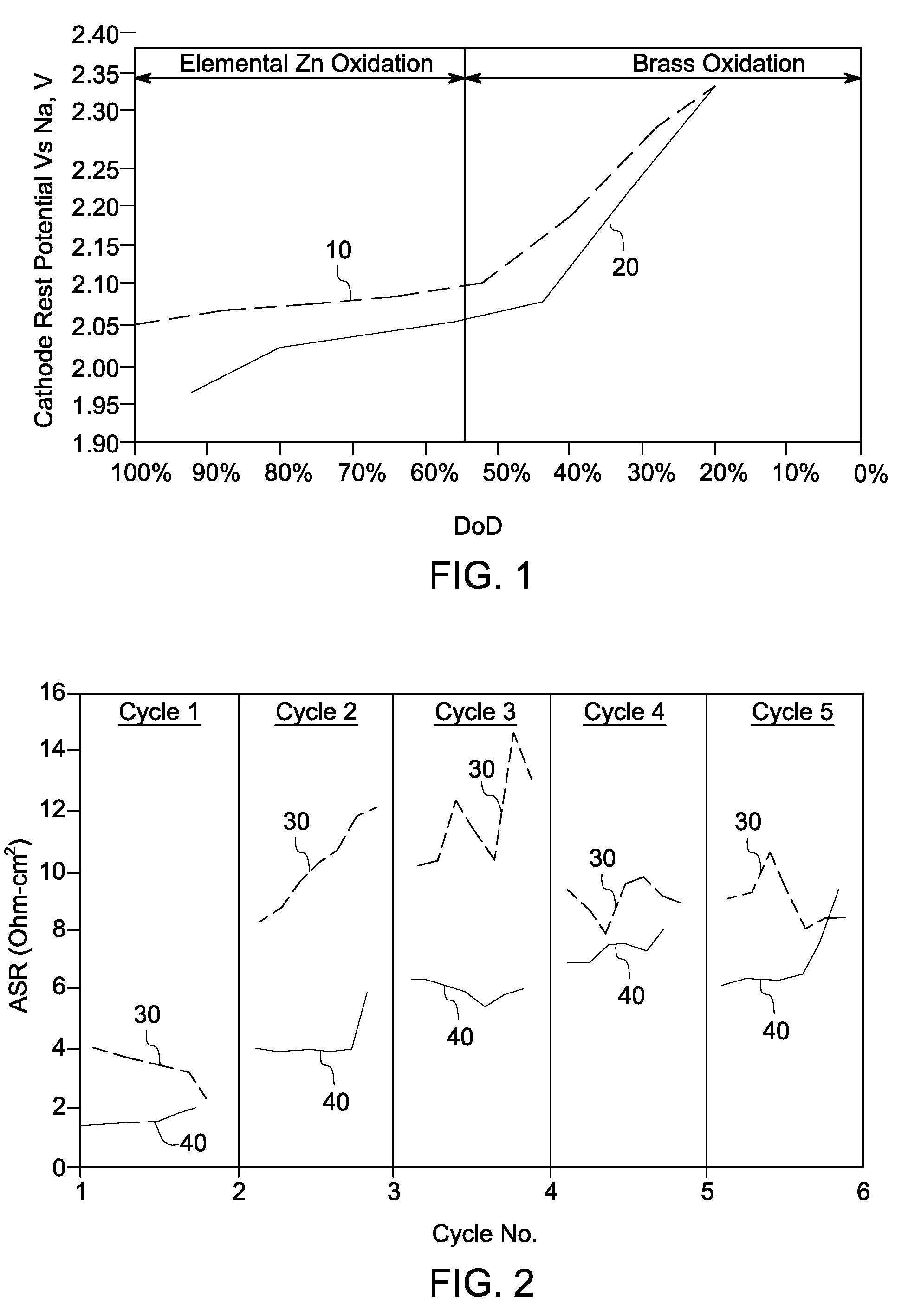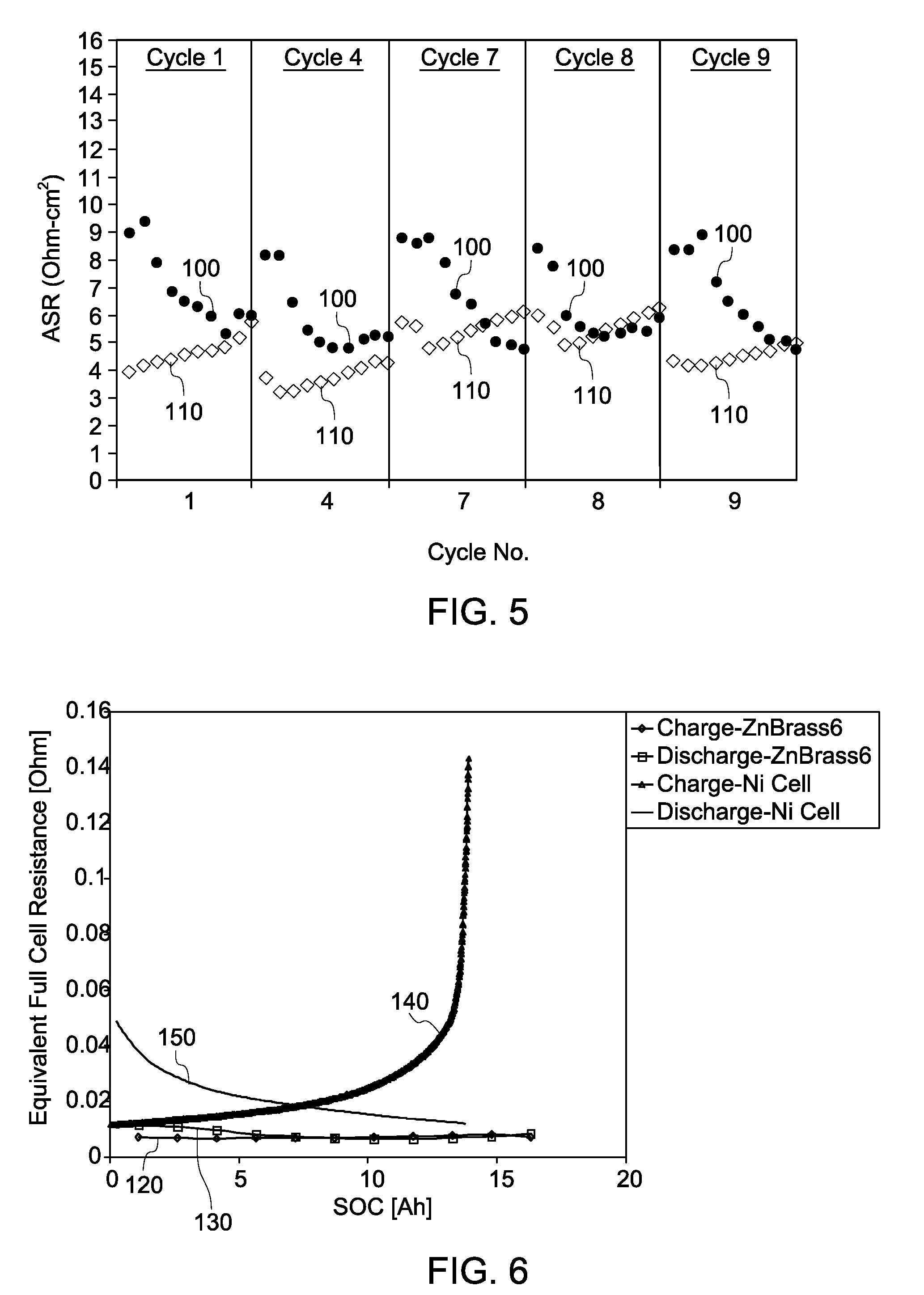Method of making and using composition and energy storage device
a technology of composition and energy storage device, which is applied in the direction of secondary cell servicing/maintenance, cell components, electrochemical generators, etc., can solve the problems of passingivation of the remaining uncharged (reduced) electrode surface and fouling of the pores
- Summary
- Abstract
- Description
- Claims
- Application Information
AI Technical Summary
Problems solved by technology
Method used
Image
Examples
example 1
[0066]The solid components of a cathodic material include zinc (Alfa Aesar Item #00424, −100 mesh, 99.9% metals basis), brass (Alfa Aesar Item #43213, −325 mesh, 99.9% metals basis), and sodium chloride (Alfa Aesar Item #87605, 99.99%). To increase the surface area for improved mass transfer, the sodium chloride is milled to −200 mesh in a laboratory mill in a dry glove box.
[0067]Ammonium bicarbonate [Sigma-Aldrich Item #A6141, 99.0% reagent grade) is mixed with the cathode precursor solids as a pore former. After 1 min of mechanical milling in an inert-atmosphere glove box, the ammonium bicarbonate powder is sieved, and the +170 mesh powder is retained for use in the cathode preparation. The presence and amount of ammonium bicarbonate influences cathode performance. Addition of 10-20 w / o ammonium bicarbonate (13-30 v / o), results in significantly higher molding pressures to achieve a determined packing density. Beneficially, this results in moldings that...
example 2
Producing an Electrolyte
[0070]Sodium chloride and aluminum chloride are mixed and melted together to produce sodium tetrachloro aluminate (NaAlCl4). Aluminum chloride is volatile when melted, so mixing and melting of the binary salt is done as a separate step before electrochemical cell fabrication.
[0071]Preparation of the binary salt is done in a nitrogen purge box to keep the materials as dry as possible. To produce a 750 gram batch of NaCl-rich (basic) sodium tetrachloro aluminate, 500 g of aluminum chloride (Sigma-Aldrich Item #294713, 99.99% reagent grade) and 250 g of sodium chloride (Sigma-Aldrich Item #204439, 99.999% reagent grade) are mixed in a 500-mL reaction vessel. The reaction vessel is sealed with a clamped lid. The lid is equipped with a gas outlet connected to a mineral oil bubbler to relieve any pressure.
[0072]The reaction vessel containing the dry powders is heated to 300 degrees Celsius, which is above the melting point of the binary salt mixture. Once melted, 5...
example 3
Preparation of Electrochemical Cells for Samples 1-4
[0074]Mixtures of sodium chloride, aluminum chloride, and zinc chloride are prepared as the electrolyte precursor material. A series of samples are formed in which the mole ratio, respectively, of sodium chloride, aluminum chloride and zinc chloride in the samples are 1) 4:1:0.2; 2) 4:1:0.5; 3) 4:1:1; and 4) 4:1:2.
[0075]Four separator tubes, cylindrical in shape, are produced according to known methods or are commercially obtained. Each tube is ceramic sodium conductive beta″ alumina. The cylinder dimensions are 228 mm length, 36 mm internal diameter, and 38 mm outside diameter. Each ceramic separator tube is glass sealed to an alpha alumina collar to form an assembly. Each assembly is placed in a stainless steel can that is the housing to form an electrochemical cell. The can size is about 38 mm×38 mm×230 mm.
[0076]The cathodic material includes zinc powder and alpha-brass powder. The cathodic material is disposed in the volume of...
PUM
| Property | Measurement | Unit |
|---|---|---|
| temperature | aaaaa | aaaaa |
| temperature | aaaaa | aaaaa |
| temperature | aaaaa | aaaaa |
Abstract
Description
Claims
Application Information
 Login to View More
Login to View More - R&D
- Intellectual Property
- Life Sciences
- Materials
- Tech Scout
- Unparalleled Data Quality
- Higher Quality Content
- 60% Fewer Hallucinations
Browse by: Latest US Patents, China's latest patents, Technical Efficacy Thesaurus, Application Domain, Technology Topic, Popular Technical Reports.
© 2025 PatSnap. All rights reserved.Legal|Privacy policy|Modern Slavery Act Transparency Statement|Sitemap|About US| Contact US: help@patsnap.com



